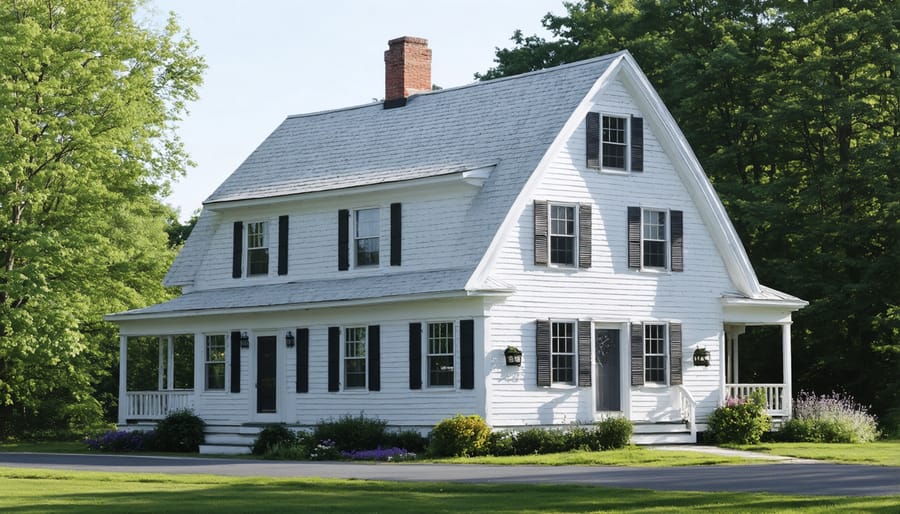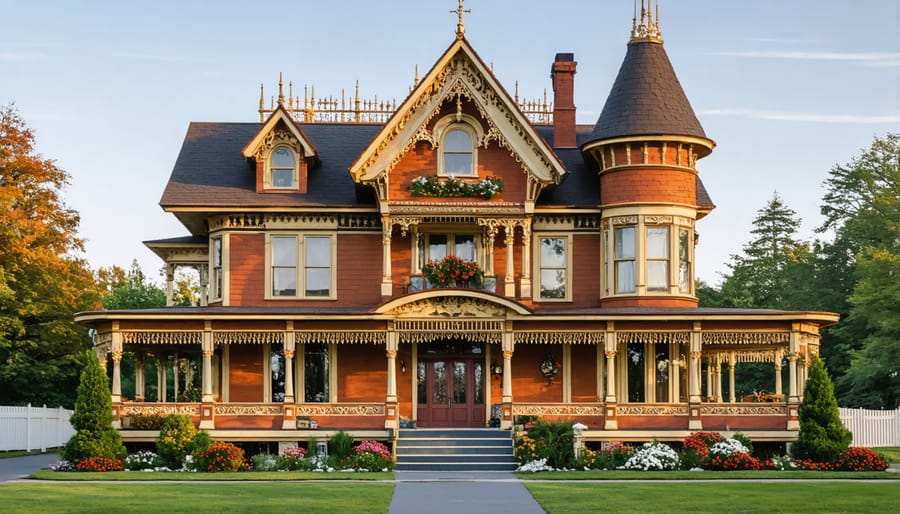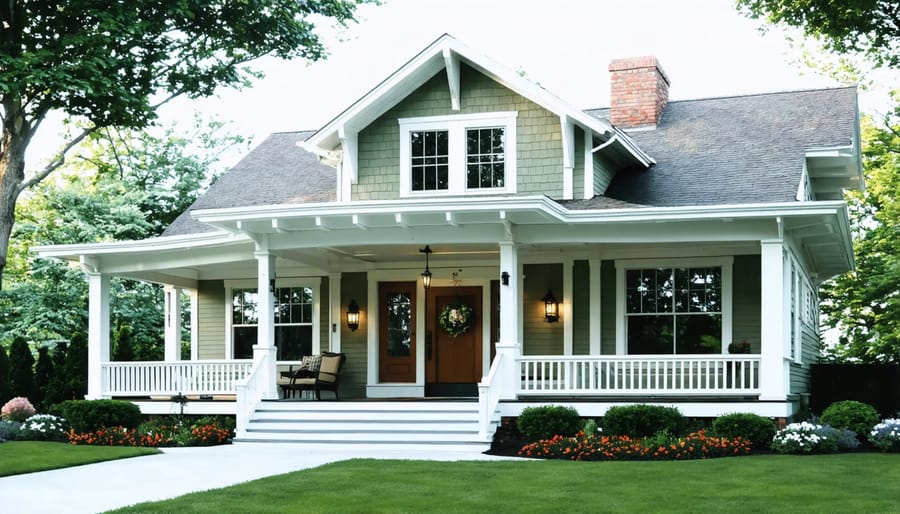From the grand columns of Colonial homes to the clean lines of Mid-Century Modern, American architecture tells the story of our nation’s evolution through distinctive designs and cultural influences. Learning to identify American architectural styles unlocks a deeper appreciation of our built heritage and helps homeowners make informed decisions about renovation and preservation.
America’s architectural journey began with practical Colonial structures in the 1600s, transformed through the ornate Victorian era, embraced the simplicity of Craftsman bungalows, and evolved into today’s contemporary designs. Each style reflects the technological advances, social changes, and design philosophies of its time – from the symmetrical grace of Georgian mansions to the innovation of Prairie School houses.
Whether you’re house hunting, planning renovations, or simply cultivating an appreciation for architectural history, understanding these distinct styles helps you recognize the unique characteristics that make American homes architectural treasures. From roof pitches to window patterns, every element tells a story of the era that shaped it.
Colonial Style (1600s-1700s)
English and Dutch Colonial
Early American homes reflected the strong influences of English and Dutch settlers, with each group bringing distinctive architectural elements from their homelands. English colonial homes typically featured symmetrical designs with steep roofs, central chimneys, and small, multi-paned windows. These practical homes were built to withstand harsh New England winters, often featuring wooden clapboard siding and simple, clean lines.
Dutch colonial homes, particularly common in New York and New Jersey, are instantly recognizable by their distinctive gambrel roofs – a design that resembles a barn’s roofline with two distinct slopes. These homes often included wide Dutch doors (split horizontally into two parts), flared eaves, and decorative shutters. The extended roof overhangs and dormers provided additional living space in the upper floor while protecting the home’s exterior from weather damage.
Both styles prioritized functionality over decoration, though Dutch homes tended to incorporate more ornamental elements like curved eaves and decorative brickwork. Today, these colonial styles continue to influence modern architecture, with many contemporary homes incorporating elements like symmetrical facades and gambrel roofs in their designs.

Spanish Colonial
Spanish Colonial architecture stands as one of America’s most distinctive and enduring styles, particularly prominent in the Southwest and Florida. These homes showcase thick stucco walls, red clay tile roofs, and charming courtyard layouts that speak to their Mediterranean heritage.
The style’s most recognizable features include graceful arched windows and doorways, wrought iron details, and exposed wooden beams known as vigas. You’ll often spot decorative tiles adorning stairs and walls, adding splashes of color and personality to these homes’ predominantly white or earth-toned exteriors.
One of the style’s most practical elements is its climate-conscious design. Deep-set windows and covered porches provide natural shade, while interior courtyards create private outdoor spaces that catch cooling breezes. The thick adobe or stucco walls work as natural insulators, keeping homes cool in summer and warm in winter.
Notable elements include bell towers, often purely decorative in modern homes, and carved wooden doors that serve as stunning focal points. Today’s Spanish Colonial homes beautifully blend historical charm with modern comfort, making them particularly appealing in warmer regions where indoor-outdoor living is celebrated year-round.
Victorian Era Styles (1837-1901)
Gothic Revival and Italianate
During the mid-1800s, American architecture took a romantic turn with the Gothic Revival and Italianate styles, both bringing European-inspired elegance to homes across the nation. Gothic Revival homes are instantly recognizable by their steep, pointed roofs and ornate decorative trim known as vergeboards or “gingerbread.” These homes often feature tall, narrow windows with distinctive pointed arches, creating a dramatic, castle-like appearance that captivated Victorian-era homeowners.
The Italianate style, equally popular during this period, drew inspiration from Italian Renaissance villas but adapted beautifully to American tastes. You’ll spot these homes by their low-pitched roofs, wide eaves supported by corbels (decorative brackets), and tall windows often crowned with elaborate hood moldings. Two or three stories high, these homes typically feature a cupola or tower, adding both height and sophistication to their silhouette.
Both styles share a love of ornamental details. Look for intricate woodwork, decorative cornices, and wraparound porches with detailed columns. While Gothic Revival homes tend toward asymmetrical designs with pointed features, Italianate houses usually maintain a more balanced, rectangular shape with rounded architectural elements.
Today, these styles remain coveted for their romantic character and craftsmanship. Many homeowners embrace their ornate details while updating interiors for modern living, proving that these 19th-century designs still capture our imagination.
Queen Anne and Second Empire
The Queen Anne and Second Empire styles, both popular during America’s Victorian era, showcase some of the most ornate and distinctive architectural features in U.S. history. Queen Anne homes, which flourished from the 1880s to 1910, are known for their playful asymmetry and decorative details. These charming homes feature wrap-around porches, decorative spindles, multiple gables, and mixed textures on their facades – often combining patterned shingles, brick, and ornamental trim.
Second Empire style, emerging slightly earlier in the 1850s-1880s, brought a touch of French sophistication to American architecture. Its most distinctive feature is the mansard roof, a dual-pitched roof with dormer windows that creates usable attic space. These homes often display ornate brackets, tall windows with elaborate hoods, and decorative cornices.
Both styles reflected America’s growing prosperity and technological advances during the Industrial Revolution. Mass-produced architectural elements became readily available thanks to railroads, allowing even middle-class homeowners to add decorative details to their homes. The styles remain popular today, particularly in historic neighborhoods, where their romantic character and intricate details continue to captivate homeowners and architecture enthusiasts alike.
Look for these homes in older urban areas and historic districts, where many have been lovingly preserved and restored to their original grandeur. Their distinctive silhouettes and ornamental features make them among the most recognizable and beloved architectural styles in American residential design.

Early 20th Century Classics
Craftsman and Prairie
The Craftsman and Prairie styles represent true American architectural innovation, emerging in the early 1900s as a response to the ornate Victorian era. Craftsman homes, popularized by the Greene brothers in California, celebrate honest materials and expert craftsmanship. These homes feature wide front porches supported by tapered columns, exposed roof rafters, and decorative brackets under deep eaves.
Inside, Craftsman homes showcase natural woodwork, built-in cabinets, and cozy fireplaces surrounded by handcrafted tiles. The style emphasizes a connection to nature through large windows and the use of local materials like stone and wood.
Meanwhile, Frank Lloyd Wright pioneered the Prairie style in the Midwest, creating homes that seemed to grow naturally from the landscape. Prairie houses are characterized by their strong horizontal lines, flat or hipped roofs with broad overhanging eaves, and rows of windows arranged in horizontal bands. These homes often feature central chimneys, open floor plans, and integrated planters or wing walls that extend into the landscape.
Both styles share a commitment to natural materials, craftsmanship, and organic integration with their surroundings. Their influence continues today, with many modern homes incorporating elements from these distinctly American styles, particularly in their emphasis on quality materials and harmonious indoor-outdoor connections.

Art Deco and Tudor Revival
The Roaring Twenties brought two distinct architectural styles that still captivate homeowners today: the glamorous Art Deco and the charming Tudor Revival. Art Deco emerged as America’s love letter to modernism, featuring bold geometric patterns, stepped facades, and decorative elements that screamed luxury and progress. You’ll spot these homes by their smooth wall surfaces, often in stucco or concrete, with zigzags, chevrons, and other stylized motifs adorning doorways and windows.
Meanwhile, Tudor Revival homes transported a bit of medieval English charm to American neighborhoods. These homes are instantly recognizable by their steep-pitched roofs, decorative half-timbering, and tall, narrow windows (often grouped) with distinctive diamond-shaped panes. Massive chimneys, often topped with decorative chimney pots, are another hallmark of this style.
Both styles reflected America’s growing prosperity and confidence. Art Deco buildings embraced the machine age with their streamlined appearance and modern materials, while Tudor Revival homes offered a sense of European sophistication and old-world craftsmanship. Today, Art Deco homes are particularly treasured in urban areas, while Tudor Revival remains popular in older suburban neighborhoods.
When renovating these homes, it’s essential to preserve their unique character-defining features. For Art Deco, maintain those distinctive geometric patterns and decorative elements. With Tudor Revival, focus on preserving the authentic half-timbering and ensuring any replacements match the original materials and designs.
Mid-Century Modern and Beyond
Ranch and Split-Level
The post-World War II housing boom introduced two distinctly American architectural innovations that would come to define suburban landscapes. Ranch style homes emerged in the 1940s, offering single-story living with open floor plans, attached garages, and seamless indoor-outdoor flow. These practical homes featured low-pitched roofs, large picture windows, and sliding glass doors leading to patios, making them perfect for casual family living.
Split-level homes arrived in the 1950s as a creative solution for building on sloped lots and maximizing living space. These distinctive houses typically featured three staggered floor levels, with the main entrance opening to a middle level containing the living room and kitchen, while bedrooms sat a half-flight up and the family room nestled a half-flight down. Both styles emphasized functionality and informal living, reflecting the changing social dynamics of mid-century America and remaining influential in modern home design.

Contemporary and Modern
Today’s American architecture embraces both innovation and sustainability, reflecting our evolving lifestyle needs and environmental consciousness. Modern homes often feature clean lines, large windows, and open floor plans, while incorporating smart technology and energy-efficient designs. These contemporary architectural trends frequently blend indoor and outdoor living spaces, with features like floor-to-ceiling windows and seamless transitions to patios or gardens.
Popular modern styles include Industrial Modern, with its exposed structural elements and raw materials; Minimalist Modern, emphasizing simplicity and functionality; and Contemporary Craftsman, which updates traditional craftsmanship with modern amenities. Many newer homes also incorporate sustainable elements like solar panels, green roofs, and recycled materials.
What’s particularly exciting is how architects are reimagining classic American styles with modern twists. You might see a Colonial-style home with a contemporary open floor plan, or a Ranch house updated with sustainable features and smart home technology. This blend of historic charm and modern functionality creates unique, livable spaces that honor our architectural heritage while embracing the future.
American architectural styles continue to shape our built environment, inspiring both preservation efforts and innovative design approaches. Today’s architects and homeowners are increasingly drawn to modern interpretations of classic styles, blending traditional elements with contemporary functionality and sustainability features.
The enduring appeal of these architectural styles lies in their ability to tell America’s story through design. From Colonial simplicity to the boldness of Mid-Century Modern, each style reflects the values, technologies, and aspirations of its era. Today’s homes often incorporate elements from multiple styles, creating unique hybrid designs that honor historical precedents while meeting modern lifestyle needs.
As we look to the future, these classic styles continue to evolve. Craftsman homes are being reimagined with eco-friendly materials, while Victorian details find new life in energy-efficient structures. Ranch-style homes are being updated with open floor plans and smart home technology, proving that good design transcends time.
Whether you’re renovating a historic property or building new, understanding these architectural styles provides valuable inspiration. Their influence extends beyond aesthetics, offering lessons in sustainability, functionality, and the creative use of local materials. By appreciating and adapting these time-tested designs, we ensure that America’s architectural heritage remains vibrant and relevant for generations to come.
